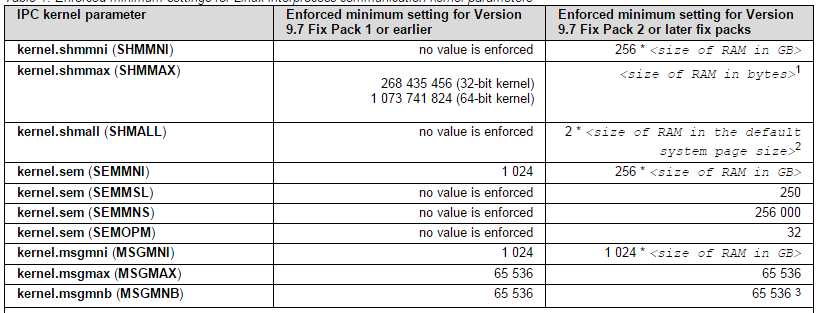标签:
系统组成:
1. 服务器OS及硬件:
OS: Red Hat Enterprise Linux Server release 6.6
Hardware: Virtual Machine, x86_64,2 core, 8GB RAM, 100GB HDD
2. 软件:
Java JDK 1.7.0 update 26
IBM DB2 Database V9.7
Sterling B2B Integrator 5.2.4
继续装插件
SAP Suite Adapter for JCo 3.x - 连接SAP系统
Oracle Database 11g Release 2 JDBC Drivers - 连接Oracle
3. 修改OS系统参数
修改参数 - 在Linux系统用户可打开文件的最大数
[root@sterling ~]# vi /etc/security/limits.conf #* soft core 0 #* hard rss 10000 #@student hard nproc 20 #@faculty soft nproc 20 #@faculty hard nproc 50 #ftp hard nproc 0 #@student - maxlogins 4 * hard nofile 10240 * soft nofile 10240 * hard memlock 3000000 * soft memlock 3000000 * hard nproc 16000 * soft nproc 16000 * hard stack 512000 * soft stack 512000 # End of file
数据库参数
[sapadm02@sterling ~]$ ipcs -l ------ Shared Memory Limits -------- max number of segments = 1024 max seg size (kbytes) = 4056980 max total shared memory (kbytes) = 33554432 min seg size (bytes) = 1 ------ Semaphore Limits -------- max number of arrays = 1024 max semaphores per array = 250 max semaphores system wide = 256000 max ops per semop call = 32 semaphore max value = 32767 ------ Messages: Limits -------- max queues system wide = 4096 max size of message (bytes) = 65536 default max size of queue (bytes) = 65536
内核参数
[sapadm02@sterling ~]$ cat /etc/sysctl.conf # Kernel sysctl configuration file for Red Hat Linux # # For binary values, 0 is disabled, 1 is enabled. See sysctl(8) and # sysctl.conf(5) for more details. # Controls IP packet forwarding net.ipv4.ip_forward = 0 # Controls source route verification net.ipv4.conf.default.rp_filter = 1 # Do not accept source routing net.ipv4.conf.default.accept_source_route = 0 # Controls the System Request debugging functionality of the kernel kernel.sysrq = 0 # Controls whether core dumps will append the PID to the core filename. # Useful for debugging multi-threaded applications. kernel.core_uses_pid = 1 # Controls the use of TCP syncookies net.ipv4.tcp_syncookies = 1 # Disable netfilter on bridges. net.bridge.bridge-nf-call-ip6tables = 0 net.bridge.bridge-nf-call-iptables = 0 net.bridge.bridge-nf-call-arptables = 0 # Controls the default maxmimum size of a mesage queue kernel.msgmnb = 65536 # Controls the maximum size of a message, in bytes kernel.msgmax = 65536 # Controls the maximum shared segment size, in bytes kernel.shmmax = 68719476736 # Controls the maximum number of shared memory segments, in pages kernel.shmall = 8589934592 kernel.shmall = 8388608 kernel.shmmni = 1024 kernel.shmmax = 4154347520 kernel.sem = 250 256000 32 1024 kernel.msgmni = 4096 kernel.msgmax = 65536 kernel.msgmnb = 65536
默认内核参数对照表

Oracle驱动参数 - 设置数据库连接
[sapadm02@sterling ~]$ cat /opt/app/gis/install/properties/jdbc_customer.properties.in ## PROPERTY_FILE_NAME ## jdbc_customer.properties.in (for initialization) ## jdbc_customer.properties (for operations) ## PROPERTY_FILE_DESCRIPTION ## The jdbc_customer.properties file has the same settings as the jdbc.properties file. This allows ## you to separate your customized database pool information (in jdbc_customer.properties) from the ## pool information provided by Application (in jdbc.properties). This arrangement ## has the following benefits: ## * During an upgrade, you can copy your jdbc_customer.properties.in file instead of cutting ## and pasting your changes out of jdbc.properties. ## * The application can make changes to the jdbc.properties file during a patch (if ## necessary) without changing a database pool that you added. ## For information about the properties in the jdbc_customer.properties file, refer to ## the documentation for the jdbc.properties file. ## DATABASE_SUPPORT: N ## Adding Database Pools ## You can use the jdbc_customer.properties file to add a new database pool to the application ## environment. You can add this pool without having to restart the application, which lets ## you continue running business processes. ## To dynamically add a new database pool, do the following: ## 1. Create the new pool in jdbc_customer.properties. ## 2. Refresh the JDBC properties by doing one of the following: ## * Click the Refresh JDBC Pools button on the JDBC Monitor page. ## * Go the the [install_dir]/install/bin directory (UNIX/Linux) or the ## [install_dir]\install\bin directory (Windows) and run the following command: ## opscmd.sh/opscmd.cmd -cREFRESHJDBC -nnode1 ## 3. Use the Database Usage page to confirm that you have added the pool. TVCSHTestPool.driver=oracle.jdbc.OracleDriver TVCSHTestPool.url=jdbc:oracle:thin:@192.168.72.109:1521:TDB TVCSHTestPool.user=IPRTVCSH_T TVCSHTestPool.password=password TVCSHTestPool.catalog=TDB TVCSHTestPool.type=remote TVCSHTestPool.testOnReserve=true TVCSHTestPool.testOnReserveQuery=select ‘x‘ from dual TVCSHTestPool.testOnReserveInterval=60000 TVCSHTestPool.max8177RetryCount=1 TVCSHTestPool.dbvendor=oracle TVCSHTestPool.buffersize=n TVCSHTestPool.maxsize=10 TVCSHTestPool.initsize=2 TVCSHTestPool.behaviour=0 TVCSHTestPool.lifespan=0 TVCSHTestPool.idletimeout=86400000 TVCSHTestPool.housekeepinginterval=3600000 TVCSHTestPool.storedProcClassName=com.sterlingcommerce.woodstock.util.frame.jdbc.OracleNoAppStoredProcQuery TVCSHTestPool.varDataClassName=com.sterlingcommerce.woodstock.util.frame.jdbc.OracleVarData TVCSHTestPool.factory=com.sterlingcommerce.woodstock.util.frame.jdbc.ConnectionFactory
Sterling B2B Integrator与SAP交互 - 02 安装配置
标签:
原文地址:http://www.cnblogs.com/slashgao/p/4912778.html